Antinol® Latest Studies
Sorted by recent
 Filter Studies by Smart Tags
Filter Studies by Smart Tags
Bone & JointCardiovascularCase Study & ProceedingCatDogEAB 277™EfficacyExotic PetImmunologyNeuro & BehaviorOphthalmologyOralRabbitRenalRespiratoryRodentSafetySkinUTI
Smart Search
Antinol® Case Study Contest 2017

10 Case Reports using PCSO-524® in combination with the treatment regimen for dogs and cats.
Pharmalink International Ltd. and Vetz Petz® would like to thank everyone involved in this 2017 Antinol® Case Study Contest competition and pay homage to our Professors and Veterinarians who have assisted in the judging of the competition.
This 2017 contest was very special with the inclusion of Professor Duncan Lascelles and the wonderful innovation of the live poll that the audience took part in to choose the Vets choice and favorite presentation.




Efficacy of PCSO-524® (VetzPetz Antinol®) for Inflammation Control in Cat with Chronic Juvenile Gingivitis Responsive to Full Mouth Extraction

The cat was having signs of juvenile gingivitis and retained deciduous dentition. Extraction of deciduous teeth were performed when the cat was 11 months old. However, gingivitis was persistent and causing severe halitosis, saliva stain on hair around the lips, drooling, and gingival overgrowth.
The cat was treated with New Zealand green-lipped mussel oil extract PCSO-524® (VetzPetz Antinol®, DKSH, Thailand) 1 capsule daily for 2 months after the extraction of deciduous teeth.
The treatment was able to reduce degree of drooling and gingivitis but could not completely eliminate the disease.
Full mouth extraction was then performed.
Post-operative care included anti-inflammatory drug, Tolfenamic acid (Tolfedine®, Vétoquinol, Best Agro; Thailand) 4 mg/kg for 3 consecutive days, Amoxicillin-Clavulanic acid (Clavamox®, Zoetis, Thailand12.5 mg/kg for 1 week, and New Zealand green-lipped mussel oil extract PCSO-524® (VetzPetz Antinol®, DKSH, Thailand) 1 capsule per day continuously.
The severity of gingivitis was rapidly decreased after the operation and within 2 weeks after the operation, the gingivitis was completely subsided.
The oil extract was administered continuously for 31 months without showing any clinical signs or impaired hematological indicators.




Treatment of Severe Hind Limb Paresis and Posterior Paresis Caused by Traumatic Myelopathy in Cats Using PSCO-524® (Antinol®) and Physical Therapy

A 2 years old domestic short hair cat weighted 3.55 kilograms was referred to Kasetsart University Veterinary Hospital for severe hind limb paresis with loss of sensory function. The onset of symptoms was observed a week ago after the cat returned from missing. Radiographic examination did not show any vertebral disorders. Magnetic Resonance Imaging (MRI) examination found accumulation of fluid in spinal cord at T10-T12 level, which indicated spinal cord injury. Traumatic myelopathy was diagnosed.
The paresis was grade 5 so PSCO-524® (Antinol®) 1 capsule per day was prescribed. After a week of the treatment, the cat was able to control urination and voluntary motor function of the hind limbs.
However, the sensory system malfunction remained. Spinal walk, walking with the hind limbs when sensation loss was observed after physical therapy was concurrently provided for 3 weeks.
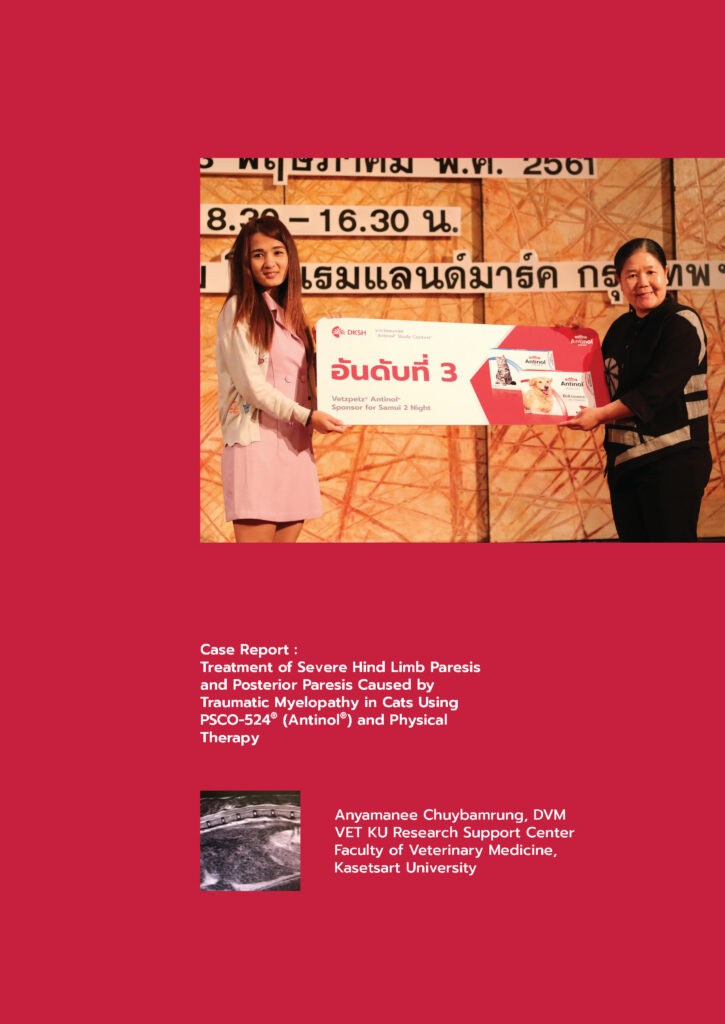
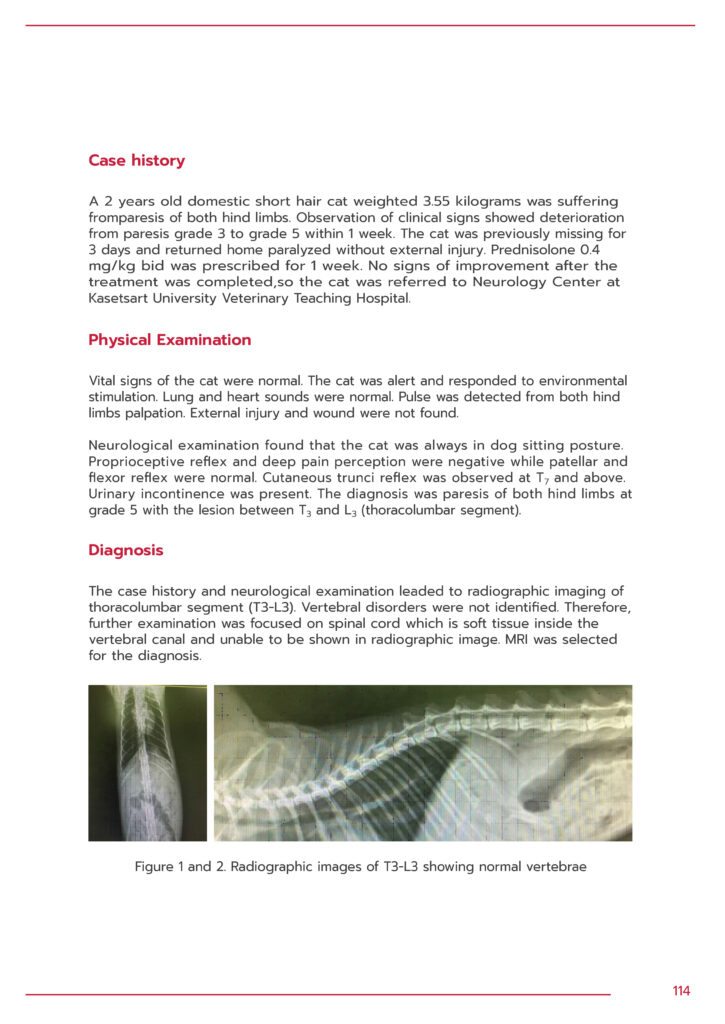
Efficacy of Oral PCSO-524®
as an Anti-Inflammatory Medicationin a Persian Cat with Pruritic Skin Disease

This is a case report of a Persian cat with severe pruritus, which was not improved by topical external parasitic treatment, food trial and 2 months treatment with oral cyclosporine at the dose 5mg/kg. The cat developed corneal ulcer after the long-term treatment with oral cyclosporine.
PCSO-524® (Antinol® Vetz Petz, New Zealand) was replaced cyclosporine as an anti-inflammation treatment and also was considered as a skin barrier support.
The cause of pruritic in this case report was still inconclusive, but the skin lesions of this cat resolved after 2 months supplement with oral PCSO-524® and external parasitic treatment with oral f vluralaner (Bravecto®, MSD).
In conclusion, oral PCSO-524® (Antinol®, Vetz Petz), could be considered as an anti-inflammation and skin barrier support when the cats could not be treated with potent anti-inflammatory medications such as corticosteroid or cyclosporine. The underlying causes of pruritic skin lesions should be corrected in order to manage feline pruritic skin diseases.




Effect of PCSO-524® Supplement on Inflammation and Pain Control and Its Safety for Orthopedic Surgery in Pregnant Cats

Bone fracture is common in stray cats. It can cause severe pain and requires surgical treatment.
Use of non-steroidal anti-inflammatory drugs (NSAIDs) or opioid drugs is common for control of pain from bone fracture. However, adverse effects are frequently reported for NSAIDs and opioid use.
Objective of this study is to evaluate anti-inflammatory and pain-relieving effects and safety of PCSO-524® (Antinol®) for bone surgery in pregnant cats.


Use of PCSO-524® Combined with Surgical Treatment of Patellar luxation in Dogs

Five dogs with bilateral patellar luxation were presented at the Small Animal Hospital of Faculty of Veterinary Medicine, Chulalongkorn University.
Four dogs had grade 2, 3, and 4 medial patellar luxation in 3, 3, and 2 stifle joints, respectively. One dog had grade 3 bilateral lateral patellar luxation that had recurrent patellar luxation of left stifle joint for 6 months after previous surgery. All dogs had surgical treatment to re-align and stabilize extensor mechanism in the normal position.
The dogs received anti-inflammatory drug and PCSO-524® in combination with rehabilitation to restore normal limb function and muscle mass postoperatively. All dogs achieved good outcomes when compared with pre-operation. Range of motion was normal in all dogs and the patellae were in the normal position.
However, one stifle with previous reluxation and severe osteoarthritis had slightly crepitation when flexed and extended the stifle joint. Patellar luxation causes abnormal wear of the patella and trochlear ridges leading to lameness, muscle pain, and osteoarthritis.
The treatment focuses on stabilization of the stifle joint and restore limb function. Surgical treatment is recommended in most cases. Rehabilitation provides strengthen muscle, improves normal joint function, enhanceslimb function, and prevents complications.
Despite successful treatment for correcting patellar luxation, osteoarthritis remains occurrence in most cases.
Therefore, use of anti-inflammatory supplement such as PCSO-524® is important for long-term management with less side effect and safety for long-term use when compared with non-steroidal anti-inflammatory drugs.
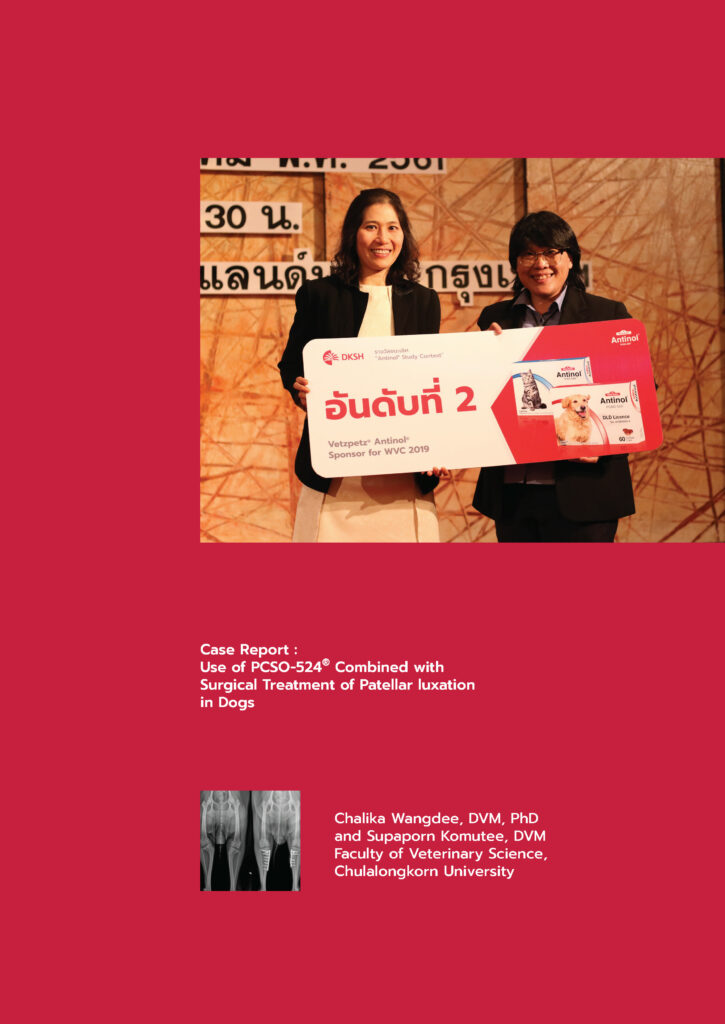
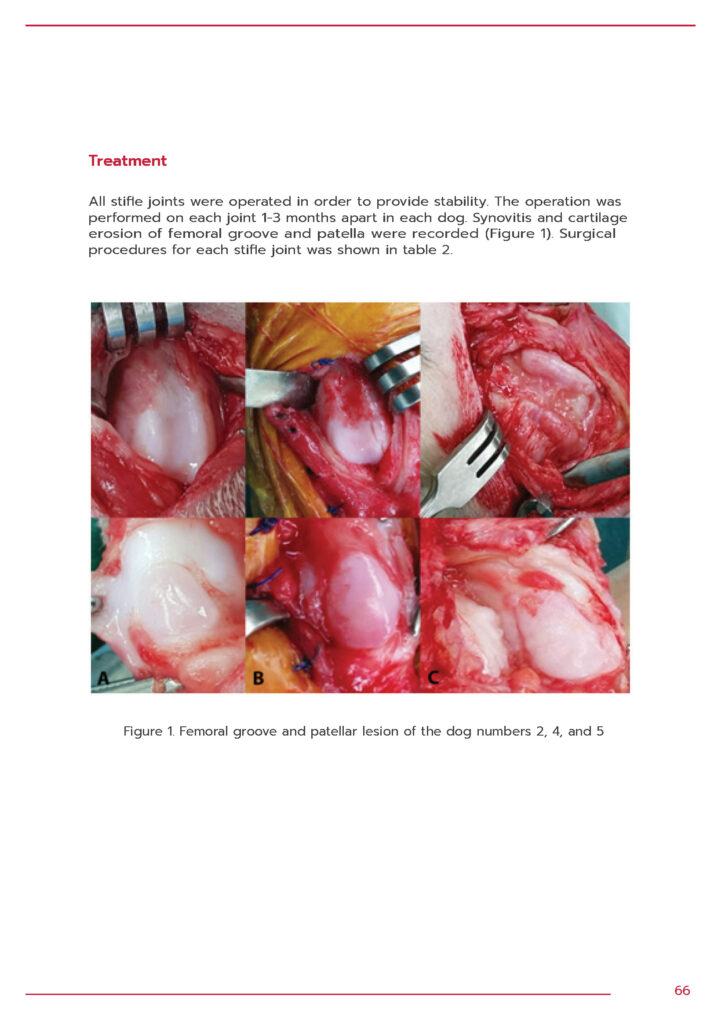
Efficacy of PCSO-524® and prednisolone combination treatment for neck pain in Chihuahua dog with Chiari-like malformation and syringomyelia

A 18-month-old male intact chihuahua presented with recurrent neck pain within 3 months after stop using prednisolone.
Upon physical and neurological examination, dog displayed pain and neck stiffness without neurological deficits. Radiographic findings of cervical spine was normal.
The dog was treated with prednisolone to relieve pain and inflammation and showed improvement of clinical signs. However, the recurrence occurred in 7 months with more severity. Magnetic resonance
imaging (MRI) demonstrated Chiari-like malformation and syringomyelia at C2-C4 and C7-T1 region.
PCSO-524® (VetzPetz Antinol®) was administered in combination with prednisolone and gabapentin. The clinical signs improved in 2 weeks so prednisolone was gradually reduced until discontinued but dose of PCSO-524® remained constantly. The dog was able to recover from neck pain and continued life activities as normal.
Long-term supplement of PCSO-524® (VetzPetz Antinol®) was effective for reducing inflammation of spinal cord in dog suffered from neck pain caused by syringomyelia.


Use of PCSO-524® for Treatment of Spine Fracture in Conjunction with Pedicle Screw-Rod Fixation (PSRF)

An intact male mixed breed dog aged 2 years engaged in a fight with several dogs resulting in disable of hind limbs and loss control of elimination. Physical and radiographic examination showed fracture and luxation of the 7th lumbar vertebrae. Spinal cord injury (SCI) was also found and the fracture was identified as the cause. The spinal cord trauma could occur since the incident and was left for more than 2 weeks.
Pedicle screw-rod fixation (PSRF) was operated to fix the vertebral column. After the second operation, it was suspected that there was remain of inflammatory cytokines that probably increased after the operation. Anti-inflammatory medication for prohibition of inflammatory cytokines synthesis was essential but its adverse effect must be concerned. The study therefore used holistic treatment including PSRF, non-steroidal drug and PCSO-524® anti-inflammatory extract, in conjunction with physical therapy.
Follow-up examination on neurological system, walking, and urinary system showed promising result. The neurological system was restored, and adverse effect of long-term use had not been found.

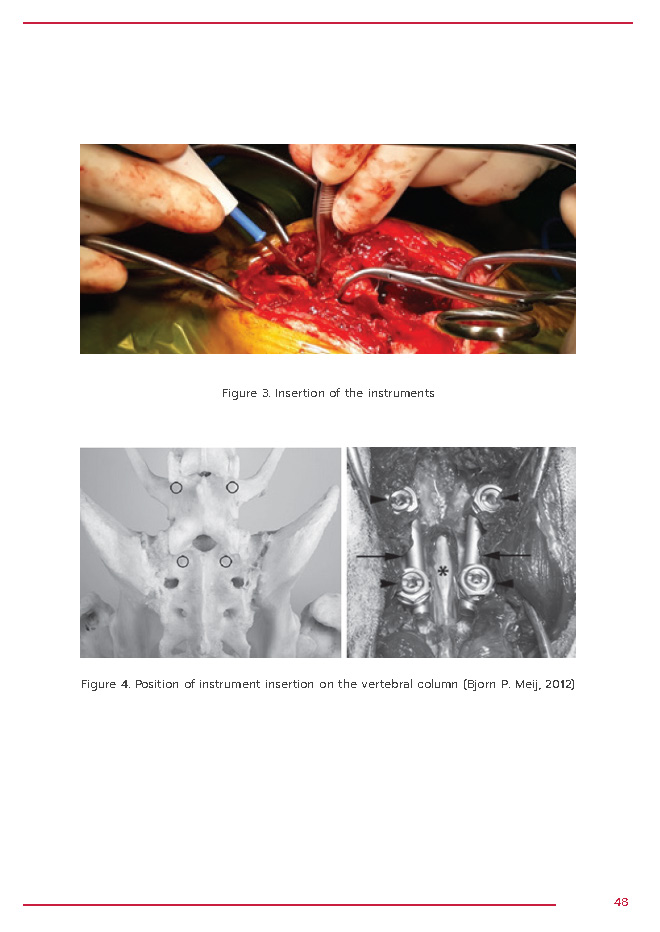
The Trial Treatment of Feline Osteoarthritis in an Eleven-Year-Old Cat

A domestic short hair cat aged 11 years was taken to the hospital due to shaking and weakened hind legs. The cat could not perform high jump for 1 month.
Preliminary diagnosis included early stage of osteoarthritis of left hip and capsulitis.
Pain killers, NSAIDs and gabapentin, were administered but the response was not satisfied. Therefore, multimodal treatment program was initiated. Physical therapy using electrical stimulation and laser beam class 4 in conjunction with PCSO-524® were used. Measurement of joint movement angle (active range of motion; active ROM) in 2 dimensions using Kinovea program was conducted for follow up.
The study found increased active ROM and decreased lameness score after the treatment.
The owner described that the cat showed less isolation behavior and was able to perform vertical jump again. Overall quality of the cat’s life was improved.
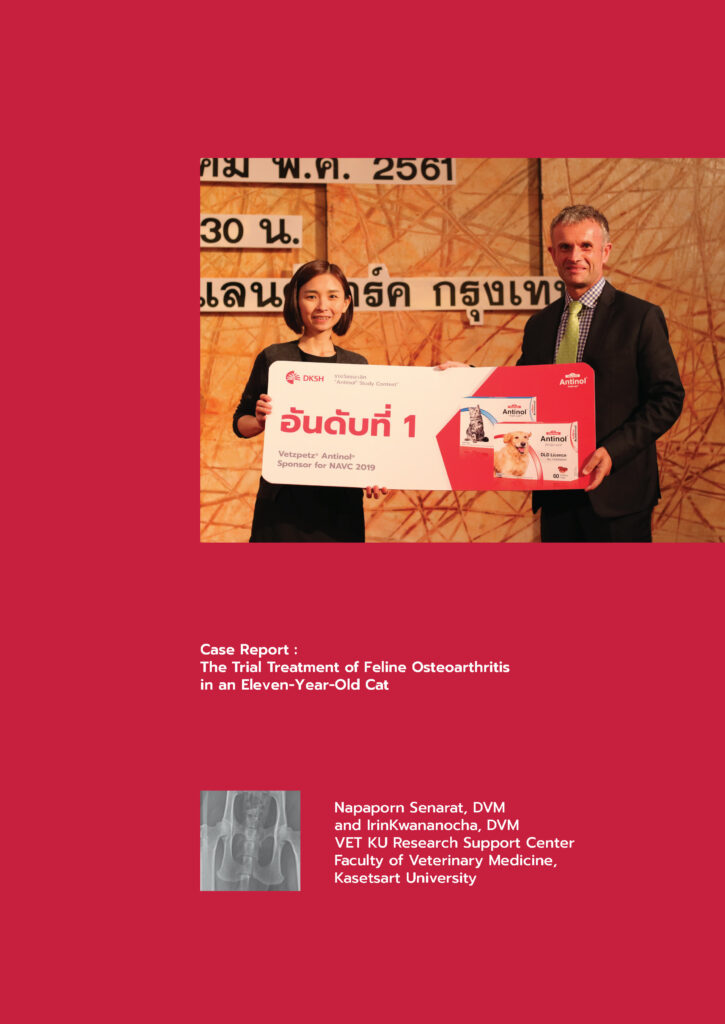

Use of PCSO-524® (Antinol)® for treatment of Obsessive-Compulsive Disorders (OCD) in Domestic Short Hair Cat

A 3 years old domestic short hair cat had shown behavioral disorder after castration 4 months ago.
The clinical signs were consistent with obsessive-compulsive disorders (OCD).
Pathological examination found edema of epidermis andinfiltration of mature mast cells in hair follicle. Treatment with PCSO-524® (Antinol)® for 180 days had shown that the misbehavior was improved due to decreased pain and skin inflammation. Healthier coat and skin appearance was noticed after 30 consecutive days of PCSO-524® (Antinol®) intake. Pathological follow-up showed less inflammation of epidermis and decreased mast cells infiltration.
It was shown that PCSO-524® (Antinol®) could reduce pain and inflammation that caused anxiety and consequently OCD in cats. Additional effects included antihistamine, antiallergy, and skin neurishing.

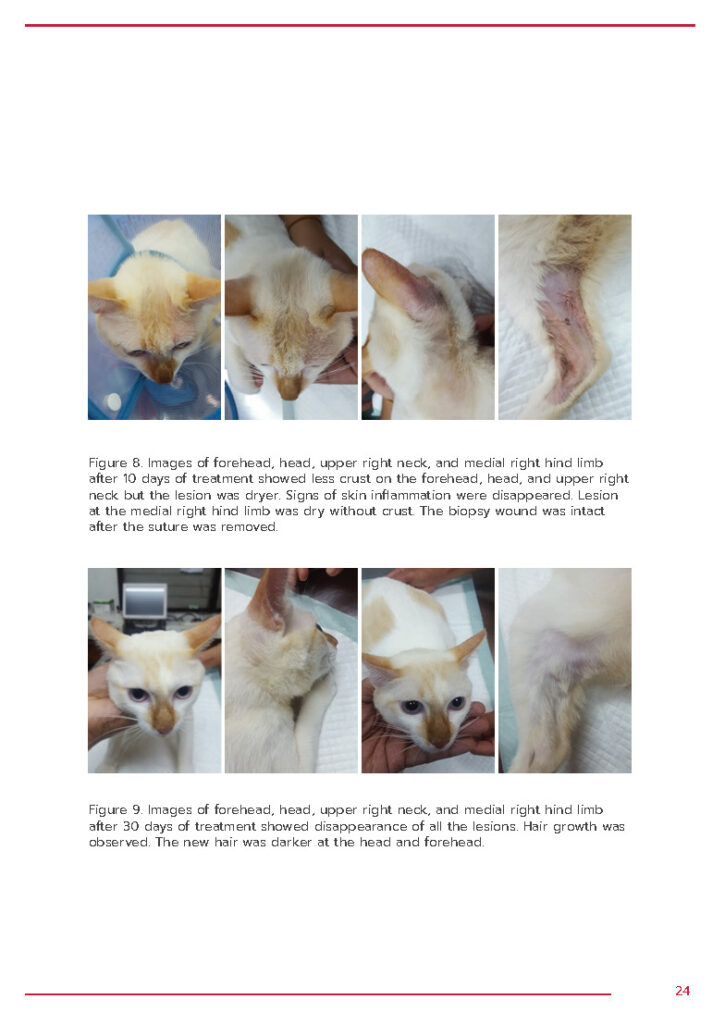
Updated Study Topics
New researches and publications related to PCSO-524® and its result in clnical test submitted by veterinarians on the global conferences every year and the data keeps growing with more studies conducted


 Authors:
Authors: